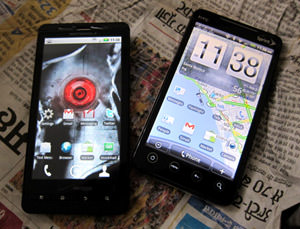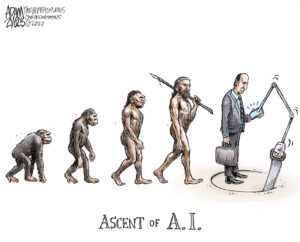Attack of the Monster Phones
The smart-phone boom has produced a new breed of giant phone that makes Apple's offering seem tiny by comparison.
Update: 1/11/11
It has been some months since I reviewed these two phones, and an update is long overdue. The day that Verizon announces it’s getting the iPhone seems as good a time as any to take care of overdue business.
I ended up making the Evo, which I reviewed rather favorably below, my own personal phone. Sadly, it has been something of a disappointment. First and foremost, the battery life, which I disparaged at the time, has only gotten worse. The more programs I install, the more widgets I keep open, the more the phone struggles to get through a morning, let alone a day. It’s pathetic. I recently went for a jog and literally outran my nearly fully charged phone.
Sprint’s network has also let me down. My 3G speeds have been consistently poor, to the point that I’ve actually found myself missing AT&T. No matter, I thought. 4G is coming. Then it came. Where to begin? In Los Angeles, where I live, certain neighborhoods don’t have any coverage at all. Some neighborhoods have coverage outside of buildings only. Even if you’re lucky enough to have coverage where you need it, turning on 4G drains the Evo’s battery even quicker and it also slows down the phone, adding a slight delay to … everything.
In light of the excellent-looking 4G LTE (read: faster and better than Sprint’s wimax) phones coming to Verizon, the new Nexus S from Google and the iPhone on Verizon, I would strongly caution against buying either phone reviewed below. Alas, with technology, time marches on. With smart phones, it sprints.
Original article:
Editor’s note: This review of the Droid X and Evo 4G phones refers to some jargon that is explained in greater depth in this companion article.
Something always seemed odd about the proposition that I had to have an iPhone. Such a proposition is made to us all, because Apple of course thinks everyone should have an iPhone, now and forever. Certainly Apple has built something that, as it evolved, worked very well for me, for my parents, my nephew, most of my friends and the endless variety of people who can be seen doing what they do in subway cars, in elevators, racing down highways, all dragging around the same white earbuds.
As good as it is, the iPhone cannot be all things to all people. Humans don’t just think different, as it turns out, they are different. It’s a fact that came to mind every time I slid my thumbs onto the iPhone’s remarkable, but tiny, virtual keyboard: They covered everything from Q to P. Yes, I have big hands, hands that are not my nephew’s or my mother’s or my friend Joel’s, with his lithe musician’s digits. I have the claws of an Eastern European peasant. They were given to me by my log-rolling, earth-tilling ancestors, and they were clearly meant more for throwing things at Russian czars than typing out e-mails at Starbucks.
|
Jump to: |
Luckily we’re in the middle of a smart-phone boom, and competition has made for a huge variety of very good devices. There are bigger phones with bigger screens now. The Google Nexus One and its cousin, the HTC Droid Incredible, for instance, have 3.7-inch screens, which are fast becoming the standard alternative to the iPhone’s 3.5-incher. That’s a start. A new Galaxy S line from Samsung has a 4-inch screen. More like it, sure, but why stop there?
There’s something about living in an empire on the verge of collapse that makes you want to arm yourself with something monstrous, and that is what I’ve gone for. There are two truly huge phones on the market that make all others appear as though they were designed for children and midgets. These machines are enormous, and well made. And when these giants of plastic and glass and metal are put to work, they flaunt some of the biggest muscles ever squeezed into something you could still drop in your pocket.
(There are actually even bigger devices, such as the Dell Streak, that could technically be considered phones, but they would be better described as small tablets or computers, and there’s no getting them into your jeans.)
Both the HTC Evo 4G and the Motorola Droid X have 4.3-inch screens, and both are so large by comparison with most other phones that when I showed them to friends and family, there were quiet gasps. Use them on a daily basis, however, and the spectacle fades. In fact, I got so used to the size that I now struggle to use the smaller but positively normal iPhone. I find myself squinting and tapping deliberately to overcome its lack of real estate. Even the new iPhone 4, which squeezes a higher resolution than any other phone into 3.5 inches, comes off as the smart-phone equivalent of a New York apartment. It’s lovely, but where exactly am I supposed to put my shoes?
The Evo and the Droid X share more than size; they both run Google’s Android mobile operating system, and both phones have a similar list of features (1-Ghz processor, 8-megapixel camera with 720p HD video recording, HDMI-out, 512 MB of RAM, up to 32 GB expandable storage and so on). But for all these commonalities, HTC and Motorola clearly have very different visions of how to make a phone, and they have manufactured and programmed their devices accordingly.
The Droid X is more attractive and runs on Verizon’s famously fast and reliable network. Its battery lasts longer than the Evo’s, although that’s not exactly lavish praise. It has 8 GB of internal storage and a free 16 GB flash card thrown in, for 24 GB out of the box, compared with the Evo’s bundled 8 GB. The Droid can also stream media directly from the phone over your wireless home network to any DLNA compatible device, such as the Xbox 360. But the Evo has a major trick up its sleeve. It runs on Sprint’s decent-but-not-Verizon-quality network and it’s huskier than the Droid X, but the Evo is the world’s first 4G phone. Unless you live in Chicago or another nascent 4G market, that doesn’t mean much … yet. Technically, the Evo is a generation faster than the Droid X, but it all depends on what Sprint’s pending national network is really like — and how soon the carrier and its partners finish building it.
Both in software and hardware, the Evo is just soft. It’s not bad, but everything is rounded corners and gently sloping panels and it just feels a bit cheap after a while. It’s an odd sensation to have when handling something so top-notch, so loaded with guts and heft.
The Droid X, on the other hand, is hard, cold and much more attractive. It’s clear when holding it in the hand that the Droid’s designers must drive nicer cars, wear more elegant clothes and work from more tastefully decorated cubicles than their counterparts at HTC. The people who designed the Droid X have imbued it with a sense of classiness and elegance missing in the Evo. The Droid strikes many as having a teen angst aesthetic, but if you do away with those distractions — the giant probing eye background and that “droid!!!” alert that will have you reaching for the bedside pepper spray before you realize it’s just a text message — you’re left with something minimalistic and clean-looking, a phone you might find on a coffee table next to an architecture magazine.Despite being bigger than the Evo, the Droid feels lighter, and it’s thinner in places. It also manages to feel solid in the hand and pocket. It feels tougher, too, hard and menacing enough to present itself as something you might throw at the guy who just cut you off, until you thought better of it. Using the Evo, I can feel friction between my finger and the screen, whereas the Droid’s screen feels smooth and cool as I glide around it. The Droid’s screen has slightly more pixels than the Evo’s and it’s brighter, too.
I also prefer the Droid X’s hardware buttons, including a camera shutter button, to the Evo’s touch-sensitive alternative. HTC has kept the bezel of the Evo thin, which I appreciate, but it makes touch buttons a real pain and I often find, as I did with Google’s Nexus One phone, that I inadvertently send myself to the home screen or search menu when I’m in the middle of a long e-mail or text. The Droid’s buttons, by contrast, are clicky, more adult somehow.
|
Jump to: |
The respective general themes extend into the user interfaces of the two devices. Both companies have arrogantly imposed their own user-interface layers or “skins” on what’s called “stock” Android. That is, they’ve taken Google’s mobile operating system, which gets exponentially more polished and useful every few months, and globbed on a kind of theatrical facade. There are added features unique to each brand, but not many worth talking about. All this gunking up the works tends to get in the way. It’s like buying a Malibu beach house and finding that someone has installed argyle curtains over the oceanfront windows. But while these added layers can be a headache, both phones run very similar software.
HTC has been working on what it calls “Sense” for years, and it shows. Though the skin is annoying to deal with at times, Sense grew out of a need to bring crucial features to phones, some that HTC made with Microsoft’s Windows Mobile, others it built with Google’s Android. Whatever one’s feelings about these skins — and the antipathy is running high among the chattering tech press — Sense at least had a reason to exist, and, in places, it still does.
I mostly dislike the experience of Sense running on the Evo. It’s fat and bloated and the phone’s girth only makes the problem worse. A list of text messages, for example, is turned into a busy mess of text and shading and hackneyed glass effects and rounded corners to the point that I get a little shapesick. It’s like the overdesigned website you’ll never again go to, but, oh wait, it’s your phone.
Sense is not entirely senseless. The phone’s dialer, for instance, makes up for its garishness with a clever trick. When I dial 262 the phone offers a short list of contacts with that combination of numbers and letters, including “Bob,” “Amanda” and any number in my address book with the digits 262.
The thing that really impresses, though — by far the phone’s greatest software feature — is a little innovation that really ought to be on every mobile device ever sold with a Web browser. The Evo, and a few other Sense devices such as the Droid Incredible, will reflow text to fit your screen. Imagine you are reading a website that is not formatted for a mobile phone. You zoom in to get a closer look at the text, but end up having to “tennis-scroll” back and forth as you read. As you zoom in and out, the Evo wraps the sentences to fit your screen. Zoom in to the point where a single word fills the horizontal, and the Evo will give you a column of single words. Pull out, and it instantly adjusts.
As with the phone’s exoskeleton, the Droid X’s software is more polished and clean than the Evo’s. That does not make it more functional. Flicking through your contacts, the dialer, menu options and messages will win approving glances from the fashionable. But that’s the trouble with fashion. You’re better off with the Evo’s TJ Maxx looks than trying to get anything done in the Droid’s couture heels. It’s not as feature-rich, there aren’t those little touches like the Evo’s alphanumeric dialer or Web text reflow, and while it looks better, inside and out, it has a most annoying phone “feature” that you can’t get rid of. Android, like the iPhone, supports multiple home screens. Swipe through them, attach widgets and apps and contacts as you like. Some of these devices handle the home screens differently. HTC’s phones, including the Evo, let you zoom out and select the screen you want. Motorola, no doubt looking to up the ante, has inadvertently developed a case of home-screen herpes. When you swipe in either direction, a completely useless navigation bar blisters up, preventing you from accessing the frequently needed buttons below (phone, web, apps) … for a time. It goes away after a second, but that can be surprisingly frustrating for anyone who expects to be able to use the phone without delay.
What’s especially maddening about this is that it serves no real purpose. Eventually, if you stop swiping, the navbar recedes, letting you make a phone call or access your apps. It’s gone … but not permanently. You can’t eliminate it in settings. You won’t find a hidden menu where you can remove it. The only recourse is either to root your phone (you probably don’t want to if you’ve never heard the term) or download a home replacement such as LauncherPro from the Android Market; it’s the cure for what ails the Droid X. Otherwise Motorola’s little design flourishes, while mostly useless, are attractive and don’t interfere with the phone’s functions.Camera
The Droid X’s camera was designed rather ingeniously to take mental pictures. It does this by allowing you, after a little game of cat-and-mouse with the shutter button, to pull up a camera window that claims to take photos. When it wants to. Have something in mind? Click the shutter button and maybe it will cooperate with you. More likely, you’ll have an excellent memory of the image you wanted without all the fuss of storing it or e-mailing it to loved ones.
That’s not entirely fair. The Droid X has a dedicated camera button, a great feature, only it takes a while to get used to, and the effect is as if you’ve slipped out of space-time. There’s a lot of half-press to focus, full-press to snap, listening for audio cues, giving it a second to catch up. … Much of the guesswork and confusion go away, along with your mental picture problem, eventually. What will remain are relatively decent photos.
|
Jump to: |
The Evo camera was designed to kill vampires. Using the double LED automated flash produces a beam of simulated sunlight that will do away with the first layer of your subject’s skin. Better to keep it off. The pictures it takes are otherwise pretty nice. You can store them in your brain or on your phone, so I suppose that’s advantage: EVO.
They both do video; however, the Evo brutally drains all life from what is meant to be HD footage. The result is choppier than what the Droid X produces, and harsher. Neither will win any YouTube subscribers, at least where quality is concerned.
In addition to the 8MP sensor, the Evo has a second, 1.3MP, front-facing shooter meant for video conferencing. Unlike the iPhone 4, you can video chat with anyone over your phone’s non-WiFi data connection. As with the iPhone 4, you’ll have more trouble finding a chat partner — one who doesn’t charge, anyway — than it’s worth.
Note: To see photos and video taken with both phones, click here.
I just remembered I should say something about call quality. But you don’t buy a giant phone with a 4.3-inch screen because you’re interested in making phone calls. The Droid X and the Evo both make them and both sound good. Can we move on now?
Playing around with the Evo without 4G is like reviewing The Beatles’ “Abbey Road” on sheet music. It’s great — in theory. It shows a lot of promise. If only we could get to one of the smaller California towns (as of this writing: Modesto, Fresno, Stockton and Visalia) that Sprint has so far decided to bless with 4G. I decided to hell with it, got in my car and headed to Visalia, the closest place to Los Angeles with 4G.
Three hours later I made three important discoveries. (1) Sprint’s 4G in Visalia, Calif., really sucks. (2) Visalia, Calif., is less safe than 97 percent of American cities, according to a website that got into my head. And (3) Alejandra’s, to which I made a timid sojourn following discovery No. 2, has decent sopes.
Back in my hotel room, with the door bolted and a plastic glass full of fortifying whiskey beside me, I took stock of the situation. I came to this town, the nearest with 4G, armed with two phones. The Evo is capable of 4G and 3G, the Droid X just does 3G. Here’s the thing, though — the best 4G speeds the Evo could muster (just over 2 Mbps download) were only slightly faster than the Droid’s 3G (average 1.4 Mbps download). And the Droid’s 3G on Verizon was almost three times as fast as the Evo’s 3G on Sprint (average 0.54 Mbps download).
Still, the 4G was faster, and faster always equals better, even if you’re slower in everyplace that isn’t Visalia. Advantage: Evo.
The situation then deteriorated.
Both phones have a really handy feature. They can instantly become WiFi hotspots, sharing their cellular data connections with other WiFi-equipped devices. Once you enable this functionality, in other words, your laptop and your iPod can wirelessly connect to your phone and access the Internet.
Both devices performed well. Setup was simple and both beat the hotel’s complimentary WiFi for download speeds. But carried over WiFi to my laptop, the Evo’s 4G speed really stumbled. Although I usually got slightly faster speeds, the margin shrank somehow to be just a sliver faster than the Droid X’s 3G over WiFi. What’s worse, I got a consistently better signal from Verizon, so the average download speed was actually faster on Verizon’s 3G than Sprint’s 4G. Kicking the Evo while it was down, the Droid clobbered the HTC device in upload speed. In fact, both devices’ 3G outperformed, by a wide margin, the 4G’s upload speed, which barely registered on Ookla’s speed test running in my laptop’s Firefox browser.
Let me make something clear at this point. I was not Visalia-adjacent. I was not somewhere in the vicinity. I was in downtown Visalia, right next to the convention center. I was not there to check out the University of Phoenix; I went to that dot on a map for 4G. This is one of only four cities in California that has it, and I was barely getting a signal, a signal that vanished when I went to dinner two blocks away. A signal that flickered and nearly died when I carried the phone across the room. “OK,” I thought to myself. “You’re not going to get such great speeds without a strong signal.” But where was I supposed to find a strong signal? Chicago? I drove three hours to get to the signal I had, I was in the epicenter of this 4G town and I felt like I was wandering around the room trying to steal my neighbor’s WiFi.The people of Visalia struck me as pleasant and it is perhaps for their uncomplaining nature that Sprint chose to set up a 4G network there. If Sprint brings this level of performance to San Francisco and Los Angeles, as planned, it had better give the customer service department a pep talk. And God help the carrier when it rolls out to New York.
Having gotten that off my chest, it’s only fair to confess that out of pure stubbornness I ended up surfing on Sprint’s 4G all night, using the Evo as a WiFi hotspot, and the browsing experience was without frustration, even when streaming videos on Netflix and YouTube. I briefly switched to the Droid X, which also worked well and, again, rivaled the Evo’s 4G network for speed, but it cut out inexplicably and I had to restart the hotspot — twice in an hour of use — something that never happened with the Evo. Apparently “Droid Does” 20 minutes of hotspot before it gets bored and quits on you.
|
Jump to: |
While we’re on the subject of annoyances that make the Droid X less of a doer than advertised, one really got me. The Droid X would accept only one Gmail account from me. Native Gmail, including support for multiple accounts, is possibly the top-selling point of any Android phone (it certainly isn’t the media experience, which has been so bad for so long it leads me to wonder whether Google has enough employees).
I left Visalia disheartened. I had expected 4G to be a revelation and instead I was revolted. I hit the freeway, heading north, determined to put the whole thing behind me. And then something remarkable happened. Passing Modesto, I remembered that it, too, has 4G. I glanced at the Evo and saw that it was indeed connected. Irresponsibly running a speed test or two while driving up the 99, I was pleasantly surprised. A much stronger 4G connection (as indicated by the phone’s display) meant download speeds of well over 3 Mbps. And then Modesto was gone. But in little bursts for the rest of my journey to Berkeley, passing Fresno and even in the middle of nowhere on the 580, I pulled down the same incredible speeds. Including a few dud readings, I averaged 2.73-Mbps downloads on 4G (I also got much faster Sprint 3G speeds and slower Verizon 3G speeds).
To put this in perspective, the Evo was getting faster Internet data on a freeway than your average DSL connection plugged into a wall.
There Can Be Only One (Unless You Can Afford Two)
I intended this to be a fight. I got ahold of these two phones not just to discover which was the bigger monster, but which, regardless of size, was the better Android phone.
The Droid X is an awesome phone, and in many ways both obvious and surprising it is superior to the Evo. Sure, the Evo has 4G, but does that make up for the Droid’s looks and more reliable network? If you asked me that question in Visalia, I’d say no. But my experience on the freeways tells a different story. If and when 4G hits your hometown, it will be worth every grievance to own an Evo.
Speaking of which, the worst grievance, by far, is the Evo’s battery life. This is the Hummer of phones. It’s big, impractical and more power-hungry than Vladimir Putin. But I love it. Not just for its speed, either.
The Evo is more practical than the Droid X. It may not be as attractive, but it gets shit done. Don’t get me wrong — the Droid X is perfectly capable and the Evo is not some office phone for the humdrum accountant. But it is, for reasons that can be elusive, useful. It also tickles the nerd G spot in a way that the Droid X doesn’t, and anyone who is attracted to Android over the iPhone is either crazy or a nerd.
I’m madly in love with both these phones, and I would happily have either over just about anything else out there. In the end, the Droid X is the phone you have a torrid affair with, but the Evo is the phone you marry.Camera Samples
|
Jump to: |




Independent journalism is under threat and overshadowed by heavily funded mainstream media.
You can help level the playing field. Become a member.
Your tax-deductible contribution keeps us digging beneath the headlines to give you thought-provoking, investigative reporting and analysis that unearths what's really happening- without compromise.
Give today to support our courageous, independent journalists.






You need to be a supporter to comment.
There are currently no responses to this article.
Be the first to respond.